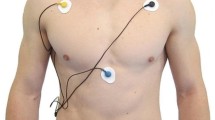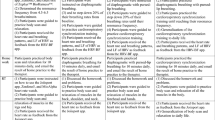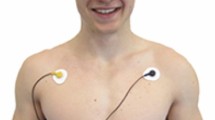Abstract
Breathing at the resonance frequency (~ 6 breaths per min) produces resonance effects on baroreflex gain, blood pressure, vascular tone, and therapeutic benefits. Evgeny Vaschillo and Paul Lehrer have emphasized that the stimulation frequency is critical for producing resonance effects in the cardiorespiratory system. Although clinicians overwhelmingly use paced breathing to increase HRV, other promising methods exist. Vaschillo, Lehrer, and colleagues have shown that presenting non-respiratory stimulation at 0.1 Hz—pictures with an emotional valence or rhythmical muscle tensing—amplifies oscillations in heart rate, blood pressure, and vascular tone. Participants in the present study included 49 undergraduate students randomly assigned to one of six different orders of 5-min trials of 1, 6, and 12 muscle contractions per min (cpm), separated by 3-min buffer periods intended to minimize carryover. This randomized controlled trial replicated the Vaschillo et al. (Psychophysiology 48:927–936, 2011. https://doi.org/10.1111/j.1469-8986.2010.01156.x) finding that 6-cpm RSMT can produce a PkFreq of ~ 0.10 Hz, similar to 6-bpm RF breathing. RSMT at 1 and 6 cpm increased five time-domain metrics (HR Max–HR Min, RMSSD, SDNN, TI, and TINN), one frequency-domain metric (LF power), and three non-linear metrics (D2, SD1, SD2) significantly more than RSMT at 12 cpm. There were no differences between 1 and 6 cpm on these measures. The 1-cpm rate (~ 0.02 Hz) may have stimulated the hypothesized vascular tone baroreflex between 0.02 and 0.055 Hz. RSMT at 1 or 6 cpm provides clients with an alternative exercise for increasing HRV for patients who find slow-paced breathing challenging or medically unsafe.








Similar content being viewed by others
References
Acland, E. L., Colasante, T., & Malti, T. (2019). Respiratory sinus arrhythmia in childhood: Evidence for a quadratic effect. Developmental Psychobiology, 61(8), 1146–1156. https://doi.org/10.1002/dev.21872
Akselrod, S., Gordon, D., Ubel, F. A., Shannon, D. C., Berger, A. C., & Cohen, R. J. (1981). Power spectrum analysis of heart rate fluctuation: A quantitative probe of beat-to-beat cardiovascular control. Science, 213, 220–222. https://doi.org/10.1126/science.6166045
Alkon, A., Boyce, W. T., Davis, N. V., & Eskenazi, B. (2011). Developmental changes in autonomic nervous system resting and reactivity measures in Latino children from 6 to 60 months of age. Journal of Developmental & Behavioral Pediatrics, 32, 668–677. https://doi.org/10.1097/DBP.0b013e3182331fa6
Berntson, G. G., Quigley, K. S., Norman, G. J., & Lozano, D. (2017). Cardiovascular psychophysiology. In J. T. Cacioppo, L. G. Tassinary, & G. G. Berntson (Eds.), Handbook of psychophysiology (4th ed.). Cambridge University Press. https://doi.org/10.1017/9781107415782
Buchanan, T. W., Bagley, S. L., Stansfield, R. B., & Preston, S. D. (2012). The empathic, physiological resonance of stress. Social Neuroscience, 7, 191–201. https://doi.org/10.1080/17470919.2011.588723
Ciccone, A. B., Siedlik, J. A., Wecht, J. M., Deckert, J. A., Nguyen, N. D., & Weir, J. P. (2017). Reminder: RMSSD and SD1 are identical heart rate variability metrics. Muscle and Nerve. https://doi.org/10.1002/mus.25573
Engert, V., Linz, R., & Grant, J. A. (2019). Embodied stress: The physiological resonance of psychosocial stress. Psychoneuroendocrinology, 105, 138–146. https://doi.org/10.1016/j.psyneuen.2018.12.221
Goldstein, D. S., Bentho, O., Park, M. Y., & Sharabi, Y. (2011). Low-frequency power of heart rate variability is not a measure of cardiac sympathetic tone but may be a measure of modulation of cardiac autonomic outflows by baroreflexes. Experimental Physiology, 96, 1255–1261. https://doi.org/10.1113/expphysiol.2010.056259
Hayano, J., Yasuma, F., Okada, A., Mukai, S., & Fujinami, T. (1996). Respiratory sinus arrhythmia-phenomenon improving pulmonary gas exchange and circulatory efficiency. Circulation, 94, 842–847. https://doi.org/10.1161/01.cir.94.4.842
Hayano, J., & Yuda, E. (2019). Pitfalls of assessment of autonomic function by heart rate variability. Journal of Physiological Anthropology, 38, 3. https://doi.org/10.1186/s40101-019-0193-2
Jarczok, M. N., Koenig, J., & Thayer, J. F. (2021). Lower values of a novel index of vagal-neuroimmunomodulation are associated to higher all-cause mortality in two large general population samples with 18 year follow up. Scientific Reports, 11, 2554. https://doi.org/10.1038/s41598-021-82168-6
Kazdin, A. E. (2016). Research design in clinical psychology (5th ed.). Cambridge University Press.
Kleiger, R. E., Miller, J. P., Bigger, J. T., & Moss, A. J. (1987). Decreased heart rate variability and its association with increased mortality after acute myocardial infarction. American Journal of Cardiology, 59, 256–262. https://doi.org/10.1016/0002-9149(87)90795-8
Kuusela, K. (2013). Methodological aspects of heart rate variability analysis. In M. V. Kamath, M. A. Watanabe, & A. R. M. Upton (Eds.), Heart rate variability (HRV) signal analysis: Clinical applications. CRC Press.
Lehrer, P. M. (2007). Biofeedback training to increase heart rate variability. In P. M. Lehrer, R. M. Woolfolk, & W. E. Sime (Eds.), Principles and practice of stress management (3rd ed.). The Guilford Press.
Lehrer, P. M. (2016). How does heart rate variability biofeedback work? Resonance, the baroreflex, and other mechanisms. In D. Moss & F. Shaffer (Eds.), Foundations of heart rate variability biofeedback (pp. 55–58). Association for Applied Psychophysiology and Biofeedback.
Lehrer, P. M., Kaur, K., Sharma, A., Shah, K., Huseby, R., Bhasvar, J., & Zhang, Y. (2020). Heart rate variability biofeedback improves emotional and physical health and performance: A systematic review and meta analysis. Applied Psychophysiology and Biofeedback, 45, 109–129. https://doi.org/10.1007/s10484-020-09466-z
Lehrer, P. M., Vaschillo, B., Zucker, T., Graves, J., Katsamanis, M., Velez, M. A., & Wamboldt, F. (2016). Protocol for heart rate variability training. In D. Moss & F. Shaffer (Eds.), Foundations of heart rate variability biofeedback (pp. 9–19). Association for Applied Psychophysiology and Biofeedback.
Lehrer, P., Vaschillo, E., Trost, Z., & France, C. (2009). Effects of rhythmical muscle tension at 0.1 Hz on cardiovascular resonance and the baroreflex. Biological Psychology, 81, 24–30. https://doi.org/10.1016/j.biopsycho.2009.01.003
Lehrer, P. M., Vaschillo, E., & Vaschillo, B. (2000). Resonant frequency biofeedback training to increase cardiac variability: Rationale and manual for training. Applied Psychophysiology and Biofeedback, 25, 177–191.
Lippman, N., Stein, K. M., & Lerman, B. B. (1994). Comparison of methods for removal of ectopy in measurement of heart rate variability. American Journal of Physiology, 267(1 Pt 2), H411–H4118. https://doi.org/10.1152/ajpheart.1994.267.1.H411
Moss, D., & Shaffer, F. (2017). Applications of heart rate variability biofeedback in common medical and mental health disorders. Biofeedback, 45, 2–8. https://doi.org/10.5298/1081-5937-45.1.03
Patriquin, M. A., Lorenzi, J., Scarpa, A., & Bell, M. A. (2014). Developmental trajectories of respiratory sinus arrhythmia: Associations with social responsiveness. Developmental Psychobiology, 56, 317–326. https://doi.org/10.1002/dev.21100
Porges, S. W. (1997). Emotion: An evolutionary by-product of the neural regulation of the autonomic nervous system. Annals of the New York Academy of Sciences, 807, 62–77. https://doi.org/10.1111/j.1749-6632.1997.tb51913.x
Porges, S. W. (1998). Love: An emergent property of the mammalian autonomic nervous system. Psychoneuroendocrinology, 23, 837–861. https://doi.org/10.1016/s0306-4530(98)00057-2
Porta, A., Guzzetti, S., Montano, N., Furlan, R., Pagani, M., Malliani, A., & Cerutti, S. (2001). Entropy, entropy rate, and pattern classification as tools to typify complexity in short heart period variability series. IEEE Transactions on Biomedical Engineering, 48, 1282–1291. https://doi.org/10.1109/10.959324
Shaffer, F., McCraty, R., & Zerr, C. L. (2014). A healthy heart is not a metronome: An integrative review of the heart’s anatomy and heart rate variability. Frontiers in Psychology, 5, 1040. https://doi.org/10.3389/fpsyg.2014.01040
Shaffer, F., Meehan, Z. M., & Zerr, C. L. (2020). A critical review of ultra-short-term heart rate variability norms research. Frontiers in Neuroscience, 14, 594880. https://doi.org/10.3389/fnins.2020.594880
Stein, P. K., & Reddy, A. (2005). Non-linear heart rate variability and risk stratification in cardiovascular disease. Indian Pacing and Electrophysiology Journal, 5, 210–20. PMCID: PMC1431594
Tarvainen, M. P., Lipponen, J., Niskanen, J.-P., & Ranta-aho, P. O. (2021). Kubios HRV software user’s guide version 3.5. Kubios Oy.
Task Force of the European Society of Cardiology and the North American Society of Pacing and Electrophysiology. (1996). Heart rate variability: Standards of measurement, physiological interpretation, and clinical use. Circulation, 93, 1043–1065.
Vaschillo, E. G. (1984). Dynamics of slow-wave cardiac rhythm structure as an index of functional state of an operant. Unpublished Doctoral dissertation. Institute of Experimental Medicine.
Vaschillo, E. G., Bates, M. E., Vaschillo, B., Lehrer, P., Udo, T., Mun, E. Y., & Ray, S. (2008). Heart rate variability response to alcohol, placebo, and emotional picture cue challenges: Effects of 0.1 Hz stimulation. Psychophysiology, 45, 847–858. https://doi.org/10.1111/j.1469-8986.2008.00673.x
Vaschillo, E., Lehrer, P., Rishe, N., & Konstantinov, M. (2002). Heart rate variability biofeedback as a method for assessing baroreflex function: A preliminary study of resonance in the cardiovascular system. Applied Psychophysiology and Biofeedback, 27, 1–27. https://doi.org/10.1023/a:1014587304314
Vaschillo, E. G., Vaschillo, B., & Lehrer, P. (2006). Characteristics of resonance in heart rate variability stimulated by biofeedback. Applied Psychophysiology and Biofeedback, 31, 129–142. https://doi.org/10.1007/s10484-006-9009-3
Vaschillo, E. G., Vaschillo, B., Pandina, R. J., & Bates, M. E. (2011). Resonances in the cardiovascular system caused by rhythmical muscle tension. Psychophysiology, 48, 927–936. https://doi.org/10.1111/j.1469-8986.2010.01156.x
Vaschillo, E. G., Zingerman, A. M., Konstantinov, M. A., & Menitsky, D. N. (1983). Research of the resonance characteristics for cardiovascular system. Human Physiology, 9, 257–265.
Yasuma, F., & Hayano, J. (2004). Respiratory sinus arrhythmia: Why does the heartbeat synchronize with respiratory rhythm? Chest, 125, 683–690. https://doi.org/10.1378/chest.125.2.683
Acknowledgements
We thank the students who participated in this research, as well as the research assistants who helped to collect these data.
Author information
Authors and Affiliations
Corresponding author
Ethics declarations
Conflict of interest
No authors have conflicts of interest to report.
Additional information
Publisher's Note
Springer Nature remains neutral with regard to jurisdictional claims in published maps and institutional affiliations.
Rights and permissions
About this article
Cite this article
Shaffer, F., Moss, D. & Meehan, Z.M. Rhythmic Skeletal Muscle Tension Increases Heart Rate Variability at 1 and 6 Contractions Per Minute. Appl Psychophysiol Biofeedback 47, 183–192 (2022). https://doi.org/10.1007/s10484-022-09541-7
Accepted:
Published:
Issue Date:
DOI: https://doi.org/10.1007/s10484-022-09541-7




